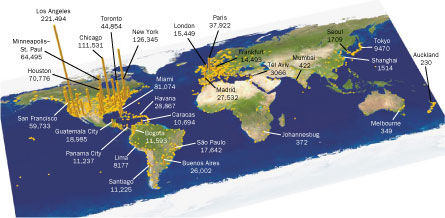- More than 2 years ago
H1N1 didn’t have a ticket to ride, but that didn’t stop the virus from tagging along on airplane trips around the world. Scientists report online June 29 in The New England Journal of Medicine that they’ve compared flight data with H1N1 influenza infections, and such flight patterns could help public health workers understand how pandemics extend their reach.

“If we can understand the laws and rules of how people move from place to place, we can understand how infectious diseases travel the world,” says study coauthor Kamran Khan of St. Michael’s Hospital in Toronto.
Khan and his colleagues obtained international flight data from March and April 2008 and lined up the data with H1N1 influenza infections the next year. Data from the early days of this year’s H1N1 flu outbreak were not available, but researchers think patterns are generally consistent from year to year.
Between March and April of 2008, a total of 2.35 million passengers flew from Mexico to cities around the world. Of the 20 countries with the most passengers arriving from Mexico, 16 had confirmed H1N1 cases associated with travel from Mexico by May 25, 2009. Countries receiving more than 1400 passengers from Mexico were at a much higher risk of importing the virus, the new analysis shows.
Although Khan expected to find travel patterns linked to flu spread, he says he was still surprised at how tight the connection was. “The correlation was very, very strong, and that really validates our approach,” he says. The researchers plan to study how travel patterns change after people become aware of an influenza outbreak. “The science and technology to take this kind of approach are here today,” he says. “This isn’t science fiction.”






